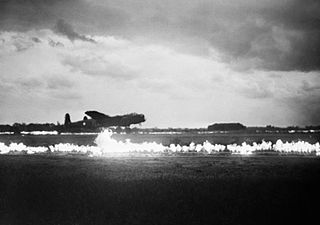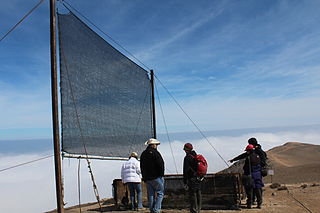
Smoke fog, or smog for short, is a type of intense air pollution. The word "smog" was coined in the early 20th century, and is a contraction (portmanteau) of the words smoke and fog to refer to smoky fog due to its opacity, and odor. The word was then intended to refer to what was sometimes known as pea soup fog, a familiar and serious problem in London from the 19th century to the mid-20th century. This kind of visible air pollution is composed of nitrogen oxides, sulphur oxides, ozone, smoke and other particulates. Man-made smog is derived from coal combustion emissions, vehicular emissions, industrial emissions, forest and agricultural fires and photochemical reactions of these emissions.

Fog is a visible aerosol consisting of tiny water droplets or ice crystals suspended in the air at or near the Earth's surface. Fog can be considered a type of low-lying cloud usually resembling stratus, and is heavily influenced by nearby bodies of water, topography, and wind conditions. In turn, fog has affected many human activities, such as shipping, travel, and warfare. Fog shows up when water vapor, or water in its gaseous form, condenses. During condensation, molecules of water vapor combine to make tiny liquid water droplets that hang in the air. Sea fog, which shows up near bodies of salty water, is formed as water vapor condenses around bits of salt.

Diamond dust is a ground-level cloud composed of tiny ice crystals. This meteorological phenomenon is also referred to simply as ice crystals and is reported in the METAR code as IC. Diamond dust generally forms under otherwise clear or nearly clear skies, so it is sometimes referred to as clear-sky precipitation. Diamond dust is most commonly observed in Antarctica and the Arctic, but can occur anywhere with a temperature well below freezing. In the polar regions of Earth, diamond dust may persist for several days without interruption.

Mist is a phenomenon caused by small droplets of water suspended in air. Physically, it is an example of a dispersion. It is most commonly seen where warm, moist air meets sudden cooling, such as in exhaled air in the winter, or when throwing water onto the hot stove of a sauna. It can be created artificially with aerosol canisters if the humidity and temperature conditions are right. It can also occur as part of natural weather, when humid air cools rapidly, notably when the air comes into contact with surfaces that are much cooler than the air.

The Great Smog of London, or Great Smog of 1952, was a severe air pollution event that affected London, England, in December 1952. A period of unusually cold weather, combined with an anticyclone and windless conditions, collected airborne pollutants—mostly arising from the use of coal—to form a thick layer of smog over the city. It lasted from Friday 5 December to Tuesday 9 December 1952, then dispersed quickly when the weather changed.
In linguistics, the Gunning fog index is a readability test for English writing. The index estimates the years of formal education a person needs to understand the text on the first reading. For instance, a fog index of 12 requires the reading level of a United States high school senior. The test was developed in 1952 by Robert Gunning, an American businessman who had been involved in newspaper and textbook publishing.

A foghorn or fog signal is a device that uses sound to warn vehicles of navigational hazards such as rocky coastlines, or boats of the presence of other vessels, in foggy conditions. The term is most often used in relation to marine transport. When visual navigation aids such as lighthouses are obscured, foghorns provide an audible warning of rock outcrops, shoals, headlands, or other dangers to shipping.

A fog machine, fog generator, or smoke machine is a device that emits a dense vapor that appears similar to fog or smoke. This artificial fog is most commonly used in professional entertainment applications, but smaller, more affordable fog machines are becoming common for personal use. Fog machines can also be found in use in a variety of industrial, training, and some military applications. Typically, fog is created by vaporizing proprietary water and glycol-based or glycerin-based fluids or through the atomization of mineral oil. This fluid vaporizes or atomizes inside the fog machine. Upon exiting the fog machine and mixing with cooler outside air the vapor condenses, resulting in a thick visible fog.
The Clean Air Act 1956 was an Act of the Parliament of the United Kingdom enacted principally in response to London's Great Smog of 1952. It was sponsored by the Ministry of Housing and Local Government in England and the Department of Health for Scotland, and was in effect until 1993.

Royal Air ForceWoodbridge or RAF Woodbridge, is a former Royal Air Force station located east of Woodbridge in the county of Suffolk, England.

A ridge or barometric ridge is a term in meteorology describing an elongated area of relatively high atmospheric pressure compared to the surrounding environment, without being a closed circulation. It is associated with an area of maximum anticyclonic curvature of wind flow. The ridge originates in the center of an anticyclone and sandwiched between two low-pressure areas, and the locus of the maximum curvature is called the ridge line. This phenomenon is the opposite of a trough.

Fog Investigation and Dispersal Operation (FIDO) was a system used for dispersing fog and pea soup fog from an airfield so that aircraft could land safely. The device was developed by Arthur Hartley for British RAF bomber stations, allowing the landing of aircraft returning from raids over Germany in poor visibility by burning fuel in rows on either side of the runway.

Longstone Lighthouse is an active 19th century lighthouse located on Longstone Rock in the outer group of the Farne Islands off the Northumberland Coast, England. Completed in 1826, it was originally called the Outer Farne Lighthouse, and complemented the earlier Inner Farne Lighthouse. The lighthouse is best known for the 1838 wreck of the Forfarshire and the role of Grace Darling, the lighthouse keeper's daughter, in rescuing survivors.

Footsteps in the Fog is a 1955 British Technicolor film noir crime film starring Stewart Granger and Jean Simmons, with a screenplay co-written by Lenore Coffee and Dorothy Davenport, and released by Columbia Pictures. The film is based on the short story "The Interruption" by W. W. Jacobs.
Out of the Fog may refer to:

The 1948 Donora smog killed 20 people and caused respiratory problems for 7,000 of the 14,000 people living in Donora, Pennsylvania, a mill town on the Monongahela River 24 miles (39 km) southeast of Pittsburgh. The event is commemorated by the Donora Smog Museum.

Lady in the Fog, released in the United States as Scotland Yard Inspector, is a 1952 British mystery film based on a BBC serial by Lester Powell as scripted by Orville H. Hampton, directed by Sam Newfield and starring Cesar Romero and Lois Maxwell. It was made by Lippert Productions and Hammer Films at the Riverside Studios in Hammersmith.

Pea soup fog is a very thick and often yellowish, greenish or blackish fog caused by air pollution that contains soot particulates and the poisonous gas sulphur dioxide. This very thick smog occurs in cities and is derived from the smoke given off by the burning of soft coal for home heating and in industrial processes. Smog of this intensity is often lethal to vulnerable people such as the elderly, the very young and those with respiratory problems. The result of these phenomena was commonly known as a London particular or London fog; in a reversal of the idiom, "London particular" became the name for a thick pea and ham soup.

Fog collection refers to the collection of water from fog using large pieces of vertical mesh net to make the fog-droplets flow down towards a trough below, known as a fog fence, fog collector or fog net. Through condensation, atmospheric water vapour from the air condenses on cold surfaces into droplets of liquid water known as dew. The phenomenon is most observable on thin, flat, exposed objects including plant leaves and blades of grass. As the exposed surface cools by radiating its heat to the sky, atmospheric moisture condenses at a rate greater than that of which it can evaporate, resulting in the formation of water droplets.
Robert M. (Bob) Cunningham was an American cloud physicist. He specialized in the study of fog, running a weather research station on Kent Island in the Bay of Fundy for over 60 years.















